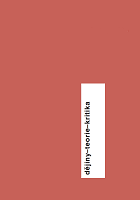Jak na (literární) antisemitismus? Modelová studie: antisemitské reprezentace u Františka Sokola-Tůmy
How to Deal with (Literary) Anti-Semitism? A Model Study: Anti-Semitic Representations in Works of František Sokol-Tůma
Author(s): Vít Strobach, Lukáš BorovičkaSubject(s): Czech Literature, Nationalism Studies, History of Antisemitism, Sociology of Literature
Published by: Univerzita Karlova v Praze - Fakulta humanitních studií
Keywords: Literary Antisemitism; Racism; Nationalism; František Sokol- -Tůma; Popular Literature;
Summary/Abstract: In this study, the authors connect the perspective of a social historian with that of a literary one. On one particular example (the works of František Sokol-Tůma), they show the potential of examining not only the inner semantic structure of a text, but also its relations to the more general social, cultural and political contexts. Building upon the basic work of Étienne Balibar, the authors hold that anti-Semitism (and racism in general) has broadly socially manifested itself not in strictly hierarchized, caste-structured societies, but paradoxically in those that claimed at least a formal principle of equality. In other words in such contexts where the discourse of social recognition on the basis of equality among people had asserted or was asserting itself while having to legitimize the obvious sharp social discrepancies. This explains why the notions of race and racism were important to Czech, German and other nationalists during the mobilization and political campaigns, and especially in the last phases of forming national movements, in asserting the sovereignty of a national state and then during its establishment and also destabilization. In Sokol-Tůma’s novel pentalogy V záři milionů (In The Blaze of Millions, 1922), the core threads of the anti-Semitic ideology are woven into a complex semantic net, which loses its ambiguity in the gradually unleashing narrative and becomes clear and understandable, even to the most “simple” reader. It is this orientation towards the “common people” that justifies the claim that the text does not leave any “clusters of ideas” to be “dissolved in a poetical play of reflection” or to be “left open”. Therefore, the pentalogy fulfills the criteria of literary anti-Semitism formulated by Mona Körte. From our point of view, however, each such analysis needs to be preceded by a precise and detailed analysis of the semantic structure of a given text and the way such text has been linked to the larger threads of the more general social, cultural and political contexts.
Journal: Dějiny - Teorie - Kritika
- Issue Year: 2017
- Issue No: 01
- Page Range: 43-77
- Page Count: 35
- Language: Czech

